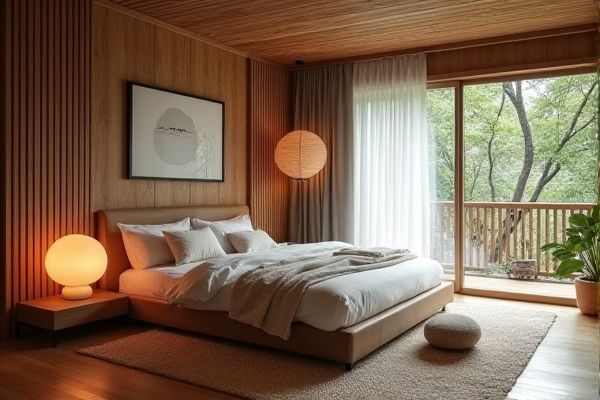
A Zen bedroom focuses on minimalism, tranquility, and natural elements to create a serene atmosphere that promotes relaxation and mindfulness, while a Boho bedroom embraces vibrant colors, eclectic patterns, and a mix of textures to express creativity and individuality. Discover how your personal style can transform your space by exploring the key differences and design tips in the rest of this article.
Table of Comparison
| Feature | Zen Bedroom | Boho Bedroom |
|---|---|---|
| Design Focus | Minimalism and tranquility | Eclectic and vibrant |
| Color Palette | Neutral tones: beige, white, soft greens | Rich, warm colors: reds, oranges, purples |
| Furniture | Simple, low-profile, functional | Varied, vintage, often handcrafted |
| Materials | Natural wood, bamboo, stone | Woven textiles, rattan, mixed fabrics |
| Decor Elements | Minimal decor, plants, Zen art | Layered rugs, throw pillows, eclectic art |
| Lighting | Soft, diffused natural light | Warm, varied light sources |
| Atmosphere | Calm, peaceful, meditative | Cozy, creative, spirited |
| Purpose | Relaxation and mindfulness | Self-expression and comfort |
Understanding Zen Bedroom Design
Zen bedroom design emphasizes simplicity, natural elements, and a calming atmosphere to promote relaxation and mindfulness, often incorporating neutral colors, minimal furnishings, and organic materials like wood and bamboo. In contrast to boho bedroom styles, which prioritize eclectic patterns, vibrant colors, and diverse textures, Zen design focuses on balance, clean lines, and uncluttered spaces to create a serene environment. Key components include low-profile furniture, soft lighting, and natural decor to foster tranquility and a connection with nature.
Key Elements of Boho Bedroom Style
Boho bedroom style emphasizes vibrant colors, eclectic patterns, and an abundance of textures, creating a warm and inviting atmosphere. Key elements include layered textiles, such as rugs and throw pillows, natural materials like rattan and wood, and an array of indoor plants that enhance the space's organic feel. Your boho bedroom thrives on personalized decor and a relaxed, free-spirited vibe that contrasts with the minimalism of a Zen bedroom.
Color Palettes: Zen vs Boho Bedrooms
Zen bedrooms feature calming, neutral color palettes dominated by soft whites, muted grays, and natural earth tones that promote relaxation and mindfulness. In contrast, boho bedrooms embrace vibrant, eclectic hues like rich reds, deep purples, and warm oranges combined with layered patterns for a lively, expressive atmosphere. Understanding these distinct color approaches helps you create a bedroom that aligns with your desired mood and style.
Furniture Choices in Zen and Boho Spaces
Zen bedrooms emphasize minimalistic furniture with clean lines, natural materials like bamboo or light wood, and low-profile beds to create a calm and uncluttered atmosphere. Boho bedrooms favor eclectic and colorful furniture, featuring vintage pieces, rattan chairs, and layered textures such as woven blankets and patterned cushions to evoke a cozy, artistic vibe. Both styles use furniture to reflect their core philosophies--Zen furniture promotes simplicity and tranquility, while Boho pieces highlight creativity and individuality.
Textures and Materials: A Comparative Analysis
Zen bedrooms emphasize natural, smooth textures like bamboo, cotton, and linen, creating a calming and minimalist atmosphere that promotes relaxation. Boho bedrooms incorporate a rich mix of tactile materials such as woven rugs, macrame, rattan, and layered textiles, resulting in an eclectic and vibrant sensory experience. The contrast between Zen's simplicity and Boho's textured complexity highlights different approaches to comfort and aesthetic harmony.
Minimalism vs Eclecticism: Design Philosophies
Zen bedrooms emphasize minimalism by incorporating clean lines, neutral colors, and clutter-free spaces to promote tranquility and mindfulness. Boho bedrooms embrace eclecticism through vibrant patterns, diverse textures, and a mix of cultural influences that create a personalized and dynamic atmosphere. Your choice between these design philosophies depends on whether you prefer a serene sanctuary or a lively, expressive environment.
Creating a Calming Ambiance: Zen Approach
The Zen bedroom emphasizes simplicity and minimalism, using neutral tones, natural materials, and uncluttered spaces to foster a tranquil atmosphere. Bamboo furniture, tatami mats, and soft ambient lighting enhance the calming ambiance by promoting mindfulness and relaxation. In contrast to the eclectic and colorful elements of a boho bedroom, the Zen approach prioritizes balance and harmony to create a peaceful sanctuary.
Bohemian Creativity: Expressing Individuality
Bohemian bedrooms showcase vibrant patterns, eclectic decor, and a mix of textures that emphasize artistic expression and personal storytelling. Zen bedrooms prioritize simplicity, natural elements, and minimalism to create a calming, clutter-free environment for relaxation. Your choice between these styles reflects how you want to balance creative individuality with tranquil harmony in your living space.
Pros and Cons of Zen Bedrooms
Zen bedrooms promote tranquility through minimalist design, natural materials, and neutral colors, fostering a calm and restful environment ideal for better sleep and stress reduction. However, the simplicity of a Zen bedroom might feel too sparse or cold for those who prefer more decorative or personalized spaces. You may find that while Zen design enhances mindfulness and relaxation, it could limit opportunities for vibrant expression or eclectic decor choices compared to a boho bedroom.
Choosing Between Zen and Boho for Your Retreat
Zen bedrooms emphasize minimalism, natural materials, and a calming color palette of neutrals and earth tones to create a serene retreat focused on simplicity and mindfulness. Boho bedrooms showcase eclectic decor, vibrant colors, and layered textures, reflecting a free-spirited, artistic vibe that encourages personal expression and relaxation. Choosing between Zen and Boho depends on your preference for either tranquil, clutter-free spaces or lively, visually rich environments that inspire creativity.
 homyna.com
homyna.com